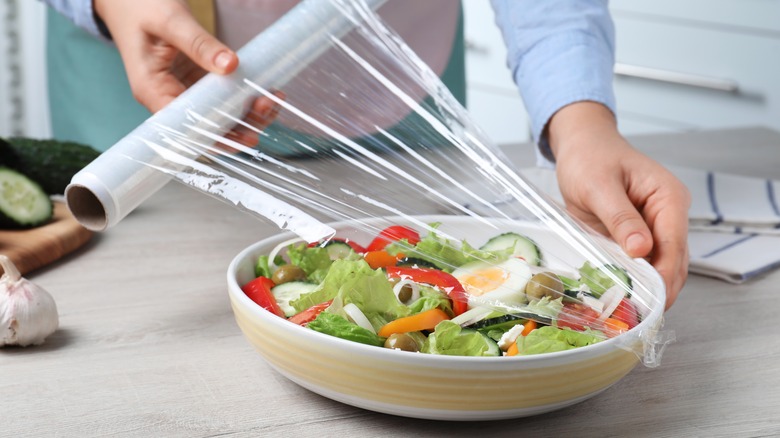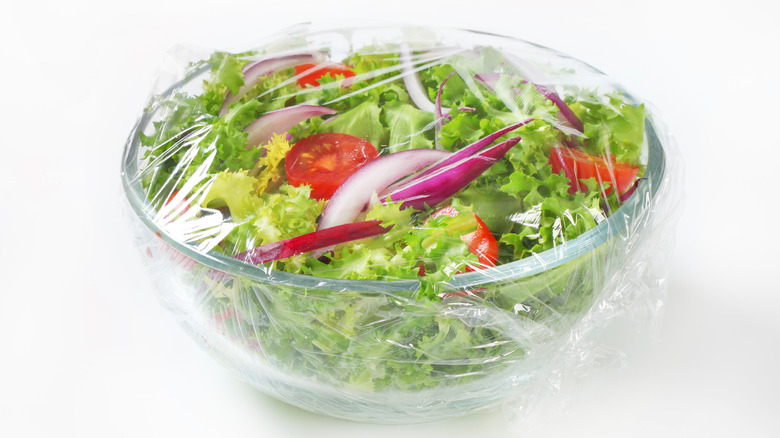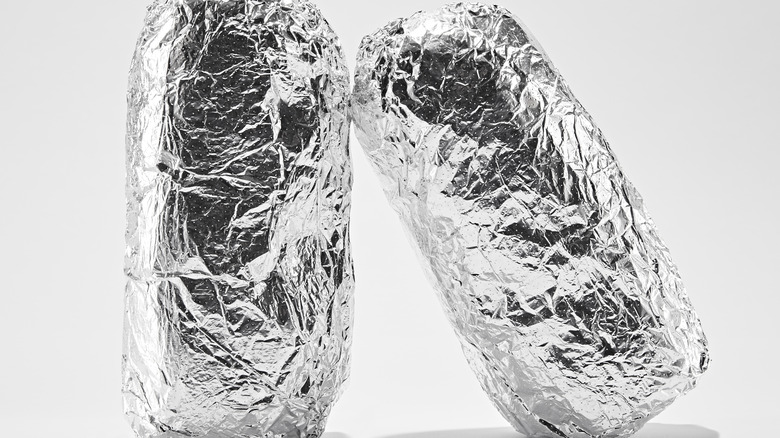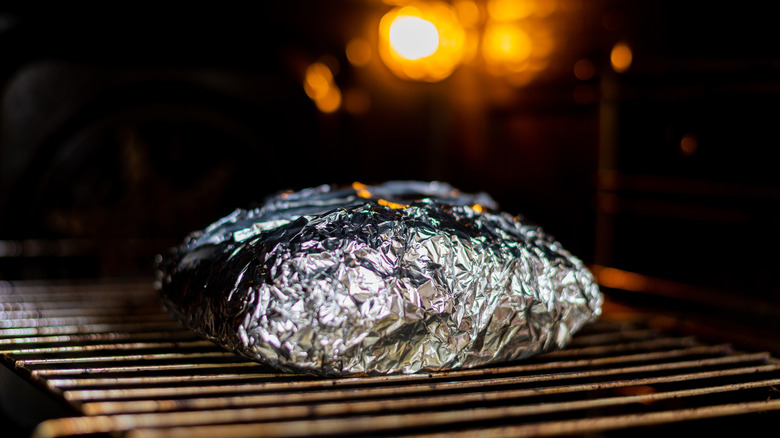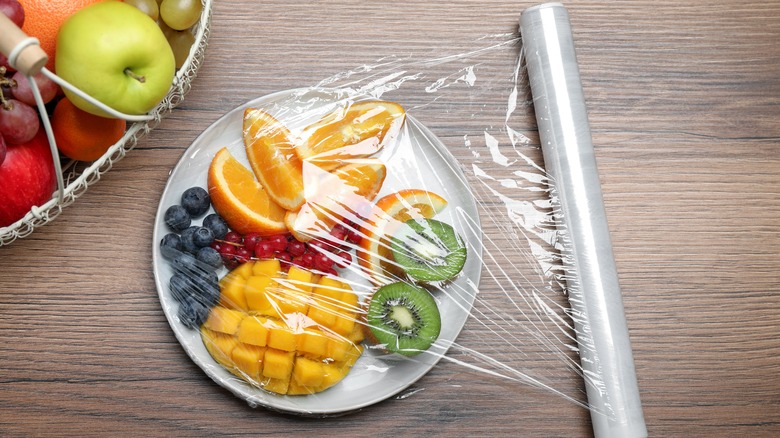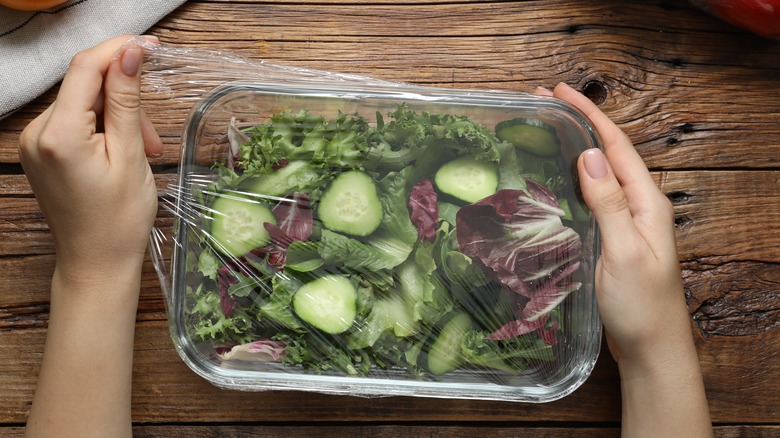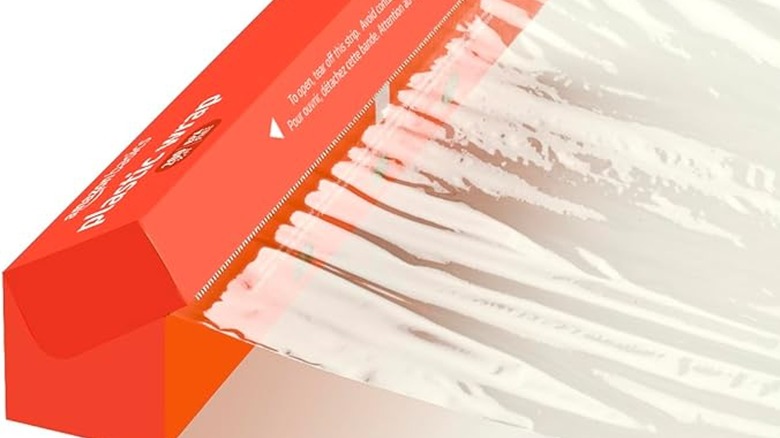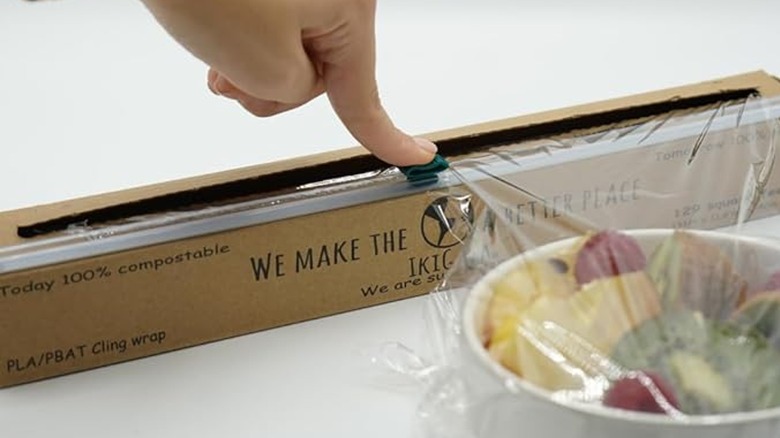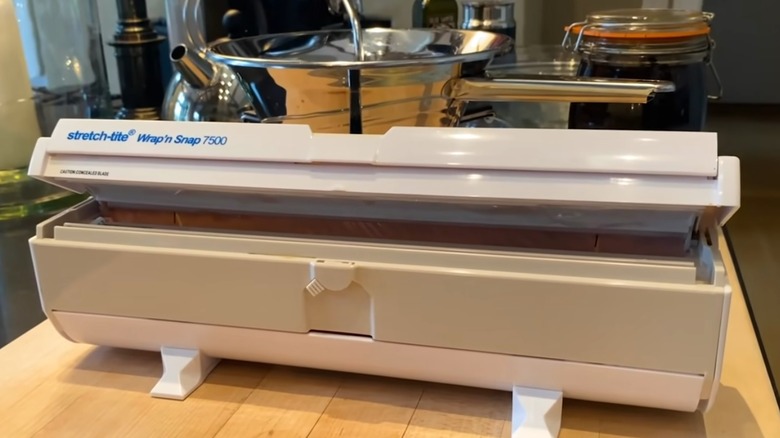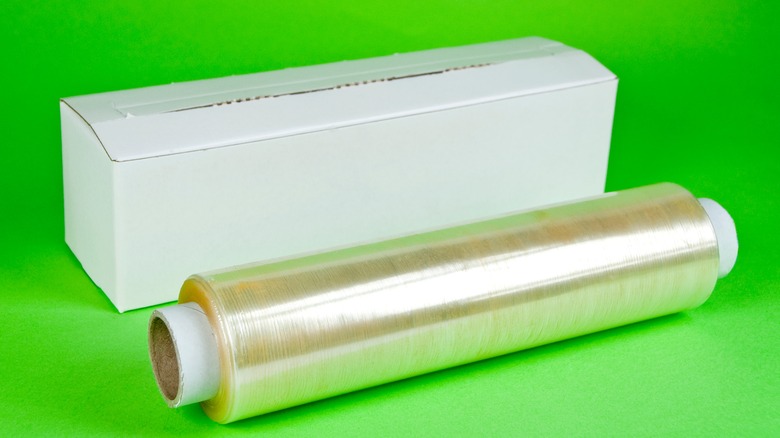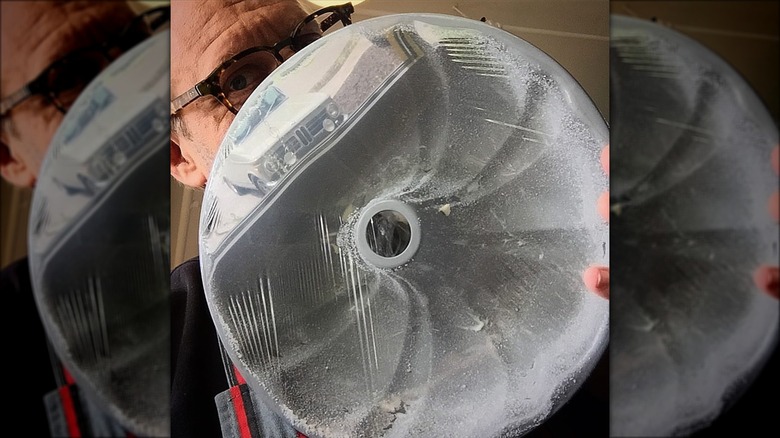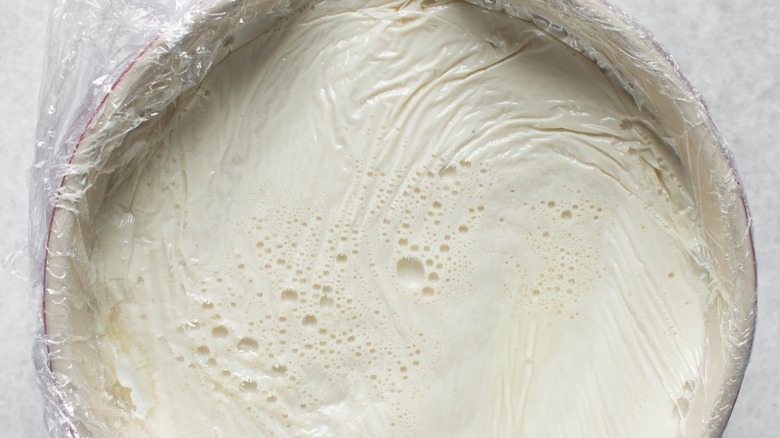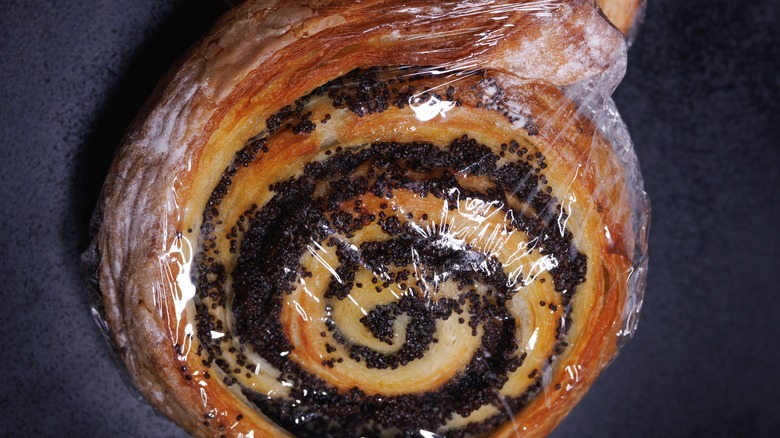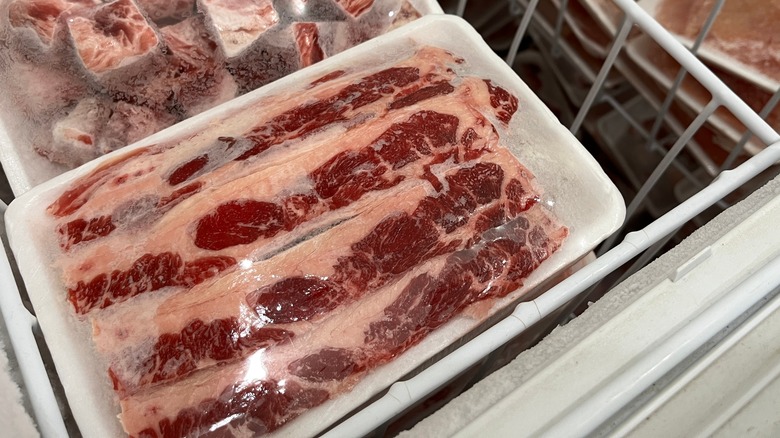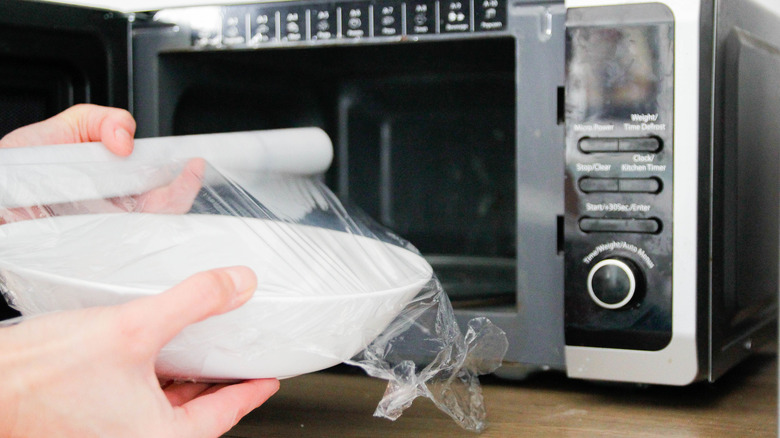14 Tips You Need When Using Plastic Wrap In The Kitchen
We may receive a commission on purchases made from links.
Using plastic wrap in the kitchen can be tricker than you might think at first glance, which is why it can help to have a few tips at your disposal. There are certainly some annoyances you're likely to encounter when using plastic wrap, like having difficulty tearing it off the roll and getting it to stick to the surface you want. There are also some tricks you probably didn't know for using plastic wrap to keep your food fresh longer. Not to mention the fact that there are more types of plastic wrap than the types you tend to find at your local grocery store.
Once you have a few tips at your disposal, you can make cling wrap work for you the way you want it to rather than approach it with annoyance. To find the best advice for how to get it to work better for us, we talked to some experts on plastic wrap: the Glad Team from the Glad company as well as Pramod Mishra, a polymer lab chemist from the Stretch-tite company. With a little research and their help, we're able to provide you with 14 super helpful tips for using plastic wrap in the kitchen.
14. Completely envelope your food or dish in plastic wrap
If you've had difficulty getting your plastic wrap to stick to your dish and keep your food wrapped, there's a trick to using it. It turns out that you're probably not using enough plastic wrap. Both the Glad Team and Pramod Mishra from Stretch-Tite explained to us that it's better to completely envelope your food or dish in plastic wrap.
The Glad Team pointed out that, not only does plastic wrap cling to materials like glass dishes, but it also clings to itself. So, you'll want to wrap the whole item in plastic wrap so the wrap reaches back around and comes in contact with itself again. Mishra suggests going a step further. He says, "Double-wrapping will help increase clinginess."
Something else that enveloping your food does is to keep it airtight. So, you're less likely to have spills, the food is more likely to stay fresh longer, and smells will stay where they belong.
13. Layer it with foil for freezing baked goods
If you want to freeze baked goods but don't have a freezer bag big enough, you can use plastic wrap instead — as long as you also use foil. Two wrapping layers makes all the difference to keep food fresh and prevent freezer burn.
Whether ordinary plastic wrap, heavy-duty types, or types meant for the freezer, your product will remain in good shape with an external foil layer to insulate it. The double layer also keeps moisture out. However, you want to let your baked goods cool completely to avoid condensation before wrapping in plastic wrap.
Some bakers suggest using Glad Press'N Seal so that you don't have to wrangle with plastic that likes to stick to itself nearly as much as it's double-sided. However, any plastic wrap will do. Finally, you'll want to completely wrap the plastic-wrapped baked goods in foil. The neat thing is that you can write directly on the foil with a marker to remind yourself what's inside and how long it's been in the freezer.
12. You can use it in the oven if layered with foil
We know that this sounds counterintuitive to everything you think you know about plastic wrap, but you can use it in the oven if you add a layer of foil. There are a lot of reasons that plastic wrap shouldn't normally go in the oven. Interestingly, some chefs add an internal layer of plastic wrap to help lock in moisture — but only at low temperatures and when wrapped in foil.
Chemistry professor Robert L. Wolke explained to the Washington Post that it works in recipes like roasted turkey because "aluminum foil shields the roast from the convection of hot air in the oven and also from infrared radiation. But the foil is so thin and insubstantial that it cannot absorb and retain enough heat to ... get hot enough to melt the plastic film beneath it." Professor Wolke continues on to say that in most cases, wet plastic film wrapped in aluminum won't get hotter than 212 degrees Fahrenheit, where it would need to be to boil off the wetness before the plastic could melt. (Most home-use plastic wraps won't melt until 220 to 250 degrees, anyway, depending on the manufacturer.)
If you're concerned about the chemical safety of getting plastic wrap hot next to your food, there are two main considerations. Luckily, most plastic wraps have been phthalate-free since 2006. However, some plastic wraps may still contain diethylhexyl adipate (DEHA). So, research your brand first if you have concerns.
11. The surface type matters
Not every surface is that same when it comes to how well plastic wrap sticks. So, if you're debating over which bowl to put your leftovers in and plan to cover it in plastic wrap, choose one that is better-suited for the job.
Not only do the types of surface matter, but different wraps stick to different surfaces better. Pramod Mishra from Stretch-Tite says that "plastic wraps are designed to cling to different surfaces, but the degree of clinginess may vary depending on the nature of the surfaces. Ceramic and glass surfaces show higher clinginess compared to the metal and wood surfaces."
So, if you plan to cover the top of your bowl with wrap, you might want to choose a ceramic or glass bowl instead of a metal or wooden one. Although, the Glad Team mentioned wood as a surface that its Press'N Seal product would cling to. So, it may depend on the brand and even the style you're using. Thus, you might need to read the package or do a little experimentation with the brand and type you're using before pulling off a whole piece.
10. The wetness level of your surface matters
Depending on what you're planning to do with your plastic wrap, you might need a dry or a wet surface. It's important to know which situation demands which.
The Glad Team told us that in most situations, its "wraps work best when used on clean, dry surfaces." So, if you're trying to get your wrap to adhere to the surface of a bowl or plate when you wrap it, you'll have better luck if you use a paper towel or clean dry cloth to clean and dry the surface first. If the surface has food or condensation, it's not going to stick as well as it should.
However, Gordon Ramsay gives the opposite advice when it comes to trying to get plastic wrap to stick to a flat surface. If you need to cover a flat surface such as a cutting board with plastic wrap and keep it flat, the surface needs to be wet. You don't necessarily need to soak the surface, but if it's slightly wet, the film will stay flat rather than wrinkling or bubbling. So, if you want to wrap something completely as mentioned in our first tip, it's going to cover more smoothly.
9. There's a right way to use the serrated cutter bar on the box
If you've ever used plastic wrap with a serrated cutter bar, there's a pretty big chance that the box has defeated you. You're often left with a poor cut or the plastic sticking to itself.
When the Glad Team told us how to use the serrated cutter bar on the box, we realized we'd been going about the cutting process all wrong. First of all, the Glad Team says to "pull [the] amount of wrap needed." That's easy enough. However, it's the second part of the process where most of us fail. You should be "pulling/tearing the wrap up and across the cutter bar (back/towards you, keeping wrap taut)." If the cutter bar is on the lower part of the box, you need to flip the box so the cutter is on top. And keeping it taut rather than loose is key.
Another tip the team mentioned is that "for large platters or bowls, hold the wrap taut and cover the object you want to wrap before cutting." Not only does the film sticking to the platter or bowl help keep it taut, but you'll also be sure to cut the right amount the first time.
8. Buy a brand that comes with a slide cutter
If you've wrangled enough with serrated cutter bars in your life, it may be time that you try opting for a box that comes with a side cutter. Life is too short to get mad at cling wrap boxes.
Pramod Mishra from Stretch-tite explains that "this style of cutter generally creates a cleaner cut than a serrated blade or scissors." So, even if you've long given up on serrated cutters and resorted to using scissors to cut a piece off the roll, you're going to love the results you get from a slide cutter. If you're not sure whether you'll like it or not, you can always buy one like Stretch-tite Premium Plastic Food Wrap that includes an optional slide cutter inside the box.
There are some other options, too. You can repurpose a box with a slider with wrap from another brand you like better. Or, you could just buy some snap-on cutters like the Gegado Plastic Wrap Cutters that come four to a packet or get a wooden box with a permanent cutter like the SpaceAid Wrap Neat. Then, if you still have a big roll of plastic wrap to finish or your favorite brand doesn't have slide cutters, you can convert the box you have.
7. Invest in a plastic wrap cutting gadget
Even though slide cutters work better, the design is still not perfect, which is why you might prefer a plastic wrap cutting gadget instead. Ina Garten caused a run on plastic wrap cutting gadgets when she created a video to demonstrate using one.
The specific gadget that Garten uses is a Stretch-tite Wrap'n Snap 7500. With this gadget, you put your plastic wrap inside, pull as much off as you need, then close down on the lid. Closing down on the lid makes both a satisfying sound and delivers the clean cut of your dreams. There's no fighting with a box necessary. It can hold rolls up with up to 750 square feet of plastic. So, it will accommodate a variety of roll sizes (just not one of the 3,000-foot rolls from Costco). Plus, it's mountable so that you can use it either on the countertop or affixed to a wall or cabinet.
6. Get it cold before using it
While it may seem like a strange tip, plastic wrap is easier to use when it's cold. So, you might want to start storing it in a cold place to make it less frustrating to use.
The Glad Team says that plastic wrap "will come off the roll and cling less to itself if it is cold. Try storing it in the fridge or freezer to make it easier to control." Even if you use the traditional type with the serrated cutter bar, it will be easier to roll out and cut.
If you've been storing your roll at room temperature, getting it cold can still help make it easier to use. Pramod Mishra from Stretch-Tite suggests, "If you're having trouble getting plastic wrap off the roll, putting them in the freezer can make peeling the film off easier." So, instead of getting angry with it, throw it in the freezer and let the cold do the magic for you. It only takes a few minutes in the freezer before the plastic will begin to behave itself so you can pull it free from the roll. Once it's warm and ready to stick to itself again, it won't be a problem because you will have had enough time to get your food wrapped.
5. Use it to more easily coat a cake pan with flour or sugar
There are lots of ways to use plastic wrap, but one novel way to use plastic wrap comes from Alton Brown who discovered how to use it to flour a cake pan more efficiently. Once you learn how to do it, you're going to wonder why you never thought to do it before.
To keep cake from sticking, the normal process of flouring a cake pan involves buttering or oiling the inside of the pan, adding flour, and then maneuvering and tapping the pan in various ways until all the surface is covered in flour. While it's not terribly difficult, it's less time-efficient than it could be.
So, what's the trick to doing it with plastic wrap? Brown says on Facebook, "To coat a bundt pan with flour or sugar, coat with butter, add 2 tablespoons of the powdery stuff, cover tightly with plastic wrap and shake." That's all there is to it. With the plastic wrap over the top, you're free to shake it rather than tap it gently because the plastic wrap prevents you from making a mess. It's a genius idea.
4. Press it into creamy refrigerated foods to reduce air exposure
When it comes to covering creamy items with plastic wrap, you've likely been covering them wrong. When you open up a container of something creamy like sour cream or yogurt or want to store something creamy in a bowl, adding plastic wrap that touches the product can keep it fresh longer.
When adding plastic wrap, you want it to make an airtight layer directly touching your product. The less air exposure it has, the longer it will last. Just with this one little trick, you can extend your creamy product's longevity by several days. If you store mousse with plastic wrap on the surface, it will prevent it from forming a layer of skin. Unfortunately, this trick only works somewhat with guacamole, which will still develop a brown surface. Luckily, the trick for guacamole is to add a thin layer of lukewarm water over the top before adding the plastic wrap.
3. Cover food with it in the freezer to prevent freezer bur
If you've had a problem with freezer burn when you've used plastic wrap for frozen goods in the past, the problem might be with your wrapping technique. Pressing plastic wrap directly onto the surface of food can keep it fresh longer in the freezer.
What you're trying to avoid is surface condensation that will ultimately lead to the formation of ice crystals. And when ice crystals form, you're more likely to have freezer burn. For example, you can use it on the surface of an ice cream cake to keep it from developing freezer burn.
Having a layer of plastic wrap directly on the surface of your food eliminates space for air between the food and wrap, thus preventing those pesky ice crystals from forming in the first place. You want the wrap to be as close to the surface of the food as possible. Granted, this solution is not for long-term storage. If you plan to keep the food in the freezer for months rather than days or weeks, you're probably better off storing it in a freezer bag.
2. Use the right type of plastic wrap for different purposes
Once you know about the different plastic wrap grades available to you, you can choose the right one for the job. Although, you may need to order some types online or get them from a restaurant supply store.
Pramod Mishra from Stretch-tite explains that regular plastic wraps (polyvinyl chloride film or PVC film) "have superior cling, tensile and elongation properties useful for multiple purposes in addition to food wrapping." The professional grade versions of these, like Reynolds Food Service Film, tend to promise more cling, stretch, and strength. Mishra says, "Other types of food wraps such as shrink wraps are designed to shrink on heating, which creates air-tight packaging." Often, you'll find these available in bag form, like Purple Q Crafts Store Shrink Wrap Basket Bags. Just make sure they're made of PVC so they're food safe.
Mishra also explains that there's a wrap type called crosslinked polyolefin. He says they "possess very high strength, but they have low elongation and cling properties. They are used in automated high speed packaging lines."
If you're planning to use plastic wrap in the freezer, there's a special type for that purpose, too. For example, Freeze-tite Plastic Wrap is 50% thicker than ordinary wrap, which can help plastic-wrapped frozen food stay fresh longer than regular wrap. Not only are they made to prevent moisture and vapor to avoid ice crystal formation, but they're also made to stick to themselves even when it's cold.
1. Take care when using it in the microwave
According to Pramod Mishra from Stretch-tite, "Plastic wraps can be used in the microwave for short duration reheating." However, he suggests a microwave time of three minutes or less. It's also important to read the label to ensure the plastic is microwave safe (not all are).
Both The Glad Team and Mishra suggested that, if you plan to microwave a product with plastic wrap, you should provide at least one inch of space between the plastic and food, leaving an opening to vent steam. This helps prevent overcooking, condensation, and melting. The Glad Team says that "foods high in fat (like bacon) or sugar (like pastries) should not come in contact with plastic wrap in the microwave" because their higher heat level can cause the wrap to melt. Even if you've left a space for the steam to vent, the Glad Team says to "Always use caution when removing wrap from heated foods."
